If you want to retain customers and generate positive word-of-mouth, then it’s essential to intentionally create a delightful customer experience.
Customer delight is not just about responding to tickets or providing the minimum required service for customers to purchase your product. You’ll need to surpass expectations. The good news is that this results in increased peer-to-peer recommendations, higher customer loyalty, and decreased customer churn.
Let's take a deeper look into customer delight and check out several examples from companies that surpass customer expectations.![Access Now: Customer Support Strategy Template [Free Tool]](https://no-cache.hubspot.com/cta/default/53/7dff7d77-3a4c-40ea-a4c8-376b827a83ab.png)
Chapters
Customer Delight Definition
Customer delight is the process of exceeding a customer's expectations to create a positive experience with your product or brand. Delight is about providing a remarkable experience to users through focusing on their needs, interests, and wishes. Discounts, gifts, promotion, or spontaneous outreach can all increase customer delight.
By going above and beyond, you can increase the chances of customers remaining loyal to your brand long-term. The goal of delight is to leave these people so satisfied and happy that they go out and sing praises to your brand.
Who is responsible for delighting prospects and customers?
To understand who is responsible for customer delight, let’s zoom out and examine the concept through the lens of the inbound methodology.
If you’re not familiar with it, the inbound methodology focuses on three major principles: attract, engage, and delight customers. At its core, the inbound experience is a customer-focused way of doing business. It’s centered around helping people effectively solve their problems and challenges — not just about making the sale.
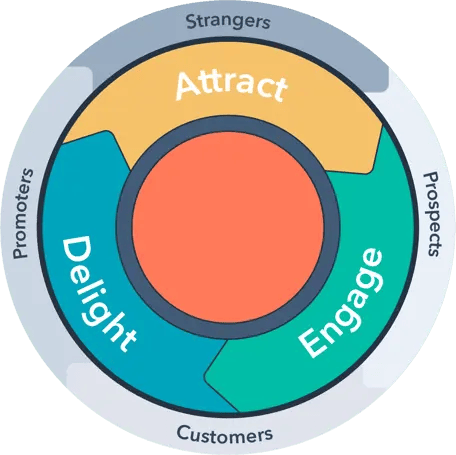
All teams play a role in the inbound process. Your marketing and service teams drive the “attract” stage that draws customers to your business. The marketing and sales teams then “engage” the lead and motivate them to convert. Finally, the sales and service teams complete this flywheel by delighting the customer with a great purchase and fantastic customer support.
Sounds simple enough, right?
Well, not quite. In a truly successful inbound organization, customer delight is everyone's responsibility — not just those people your customers may come into contact with after buying something from you.
The most successful inbound organizations have teams that collaborate to delight both their current and potential customers. Of course, your customer service and support teams play a large role here, but so do all other customer-facing departments such as marketing, sales, and product.
That's because achieving delight involves surpassing all expectations customers have throughout every interaction with your business (e.g. visiting your blog, checking out your website's pricing page, chatting with a sales rep, or asking for help using your product).
When you accomplish this, you'll build a strong relationship with your customers that makes them want to remain loyal brand advocates and promoters.
Now, you might be thinking, this sounds a lot like customer satisfaction, but they really are two different things. So, let's take a look at what makes customer delight unique from customer satisfaction.
Customer Delight vs. Customer Satisfaction
Customer delight is the process of surpassing customers' expectations to build a long-term, positive experience around your product or service and brand. Customer satisfaction happens when you simply meet customers' expectations.
Although satisfied customers are good for your company, delighted customers are more likely to become loyal customers and brand advocates for your company.
In today's competitive business world, delighting your customers rather than simply satisfying them is critical to your long-term success.
Why? Well, not only are customer expectations tougher than ever, but their recommendations to their personal and professional networks can also be the difference between your business growing or struggling.
In fact, it's easier than ever for your customers to change their products or services if you don't meet (and exceed) their expectations. Additionally, they can easily publicly share their experiences and publish average or negative feedback about your business on platforms such as Facebook, Yelp, and Google Reviews.
Also, most businesses quite literally can't afford to ignore the importance of delighting customers with the goal of retaining them. For every customer you lose, you’ll have to attract a new one, which is much more expensive.
Successful inbound organizations don't just focus on getting a customer’s business and meeting their basic needs. Instead, they aim to provide an all-encompassing remarkable customer experience that will generate delight.
Next up, let’s take a look at the factors that make a delightful — not just satisfying — customer experience.
How to Delight Your Customers
- Provide timely, almost instant support.
- Clearly publish company contact information.
- Offer each customer a personalized experience.
- Give loyal customers preferential treatment.
- Treat customers like people, not numbers.
- Solve (potential and current) customers' problems.
- Help customers succeed.
- Listen to customer feedback.
- Be enthusiastic.
- Be unexpected.
- Build a community.
1. Provide timely, almost instant support.
A critical aspect of solving problems for customers is responding to them ASAP — meaning, a big component of customer delight is the ability to be available and responsive whenever your customers reach out.
Whether the issue is big or small, show your customers that you're always prioritizing them by responding quickly. Even if you can't solve the issue right away, let them know you're working on it or escalating — this will show them you're their advocate.
Adopting a customer relationship management software, CRM, is a great way to manage interactions with your customers. With a CRM, you can record and log all emails and other forms of communication, as well as set up reminders to follow up with specific clients on various issues. Such software tools can set your business up for conversational marketing and sync your customer service cases, allowing you to keep pace with all communications and provide a more delightful customer experience.
Furthermore, whether customers meet you in a brick-and-mortar store or visiting an online SaaS business, they want to feel like if they need help, they can get it immediately. Your staffers or reps don’t necessarily need to approach the customer first, but they do need to be accessible to resolve small, one-time issues.
For an online business, this may mean adding a live chat function to the website, with either an AI chatbot or a human on the other side. Think about the pages where the live chat widget appears, too; a home page visitor might not have many questions, but someone visiting the pricing page might. Here’s one example from the HubSpot website:

For a brick-and-mortar store, you might have several clerks on the floor, ready to assist if needed. These should not be sales reps in disguise, trying to make a sale and push the customer toward a purchase decision. Instead, they should be there if the customer wants a certain item or has a quick question.
2. Clearly publish company contact information.
Let’s say that your customer needs help with their order, needs to get a complicated question answered, or simply needs to get in touch with your team.
There’s nothing worse than having to dig and dig for a company’s contact information, or feeling like the company is doing everything possible to not have to speak with you.
Customers should be able to get in contact with you easily. Even more importantly, they should have several avenues for reaching you, such as email, phone, social, and chat. This is different from the previous point in that it involves bigger issues or more than one-time questions. If a customer is reaching out directly to your team, they likely require extended help and support.
That said, you should strive to provide two different contact avenues for customers and non-customers like Zendesk does below.
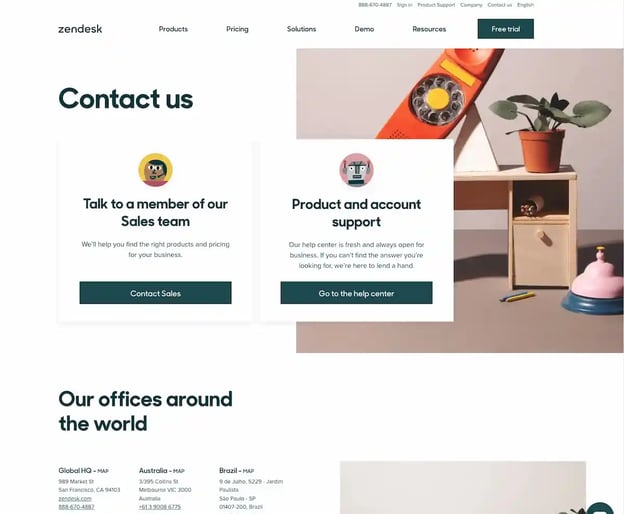
Non-customers are prompted to talk to a member of the sales team, while those who need support with their product are prompted to go to the help center. (Hot tip: Consider using a knowledge base software so that your customers can auto-troubleshoot their product issues.)
But Zendesk doesn’t stop there: It also allows visitors to get in contact with Zendesk offices around the world. There’s no attempt to hide each office’s contact information. This is an easy and simple way to delight customers.
3. Offer each customer a personalized experience.
We can’t overstate the importance of personalizing the experience for each customer. Addressing them by their names in each email, sending offers that solve their specific pain points, and pitching products to them that they actually need — these seemingly small gestures makes customers feel like you’re trying to help them, not just sell to them.
You can start by providing a personalized experience through your website. For instance, if you’re an ecommerce retailer, you might only recommend products that are related to the user’s browsing history. For instance, after I looked up a pair of Dr. Martens boots on Amazon, this was on my homepage the next day:
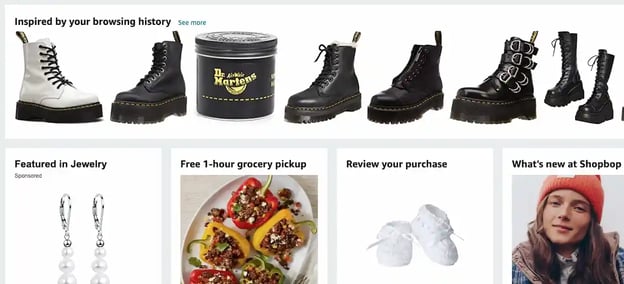
And Amazon doesn’t stop there. When you first sign in to your account, you’re taken to a “Top picks for you” page first, where Amazon resurfaces products you’ve either looked at or purchased a while back.
On your journey to delight customers, be sure to speak to their needs and interests at every step.
4. Give loyal customers preferential treatment.
A loyal customer is a gold mine. Not only are they more likely to recommend your business to others, but the likelihood of them churning is low. As such, it’s important to not take them for granted.
Loyal customers might not expect much. They likely enjoy the products you sell and/or the experience you offer, and that’s why they’re staying. But you can easily surpass expectations — and generate customer delight — by offering them perks, discount codes, and long-term benefits.
A strong customer loyalty program will make your customers feel appreciated while securing their future business. Ulta’s Ultamate rewards program, for instance, prompts customers to keep shopping by offering points that can be redeemed as cash during the checkout process.
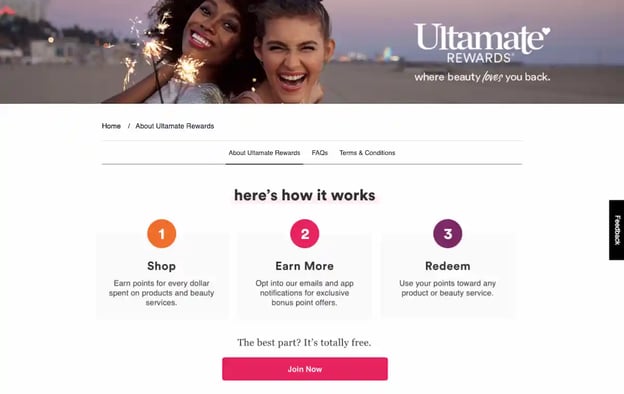
You might offer something similar as customers stay longer with you. Either way, it’s important to show your loyal customers how much you appreciate them. That gesture will exceed their expectations and delight them.
5. Treat customers like people, not numbers.
It’s easy for us to look at customers in terms of revenue. How much repeat business are they giving us? How much are they worth in terms of monthly recurring revenue? While keeping track of these metrics is a great way to measure customer satisfaction, they prevent us from seeing customers for what they are: People who have problems and goals.
Customers don’t want to feel like we see them as dollar signs. They want to feel like we can offer a solution that helps them with their problems and goals. If you fail to treat customers like three-dimensional people first, then you won’t be able to create a delightful experience.
The first place where you should make it clear you’re trying to help is on your homepage. On HubSpot’s home page, we speak to our customers’ pain points with the following heading: “Powerful, not overpowering.”
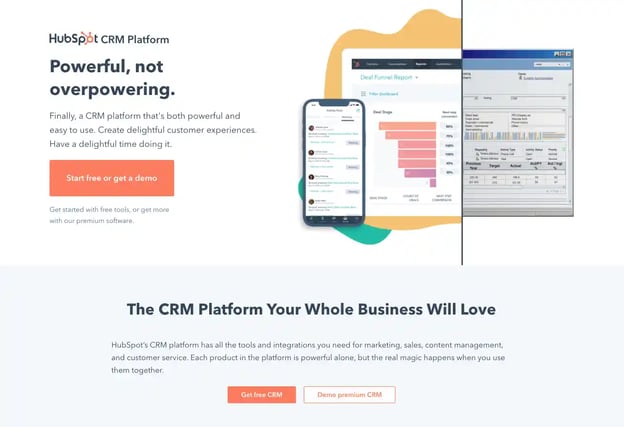
Compare that with a heading such as “Buy the best CRM platform right now.” That makes the customer feel like we’re trying to get something from them — not trying to offer them a product that will make their work easier.
Here are a few quick tips for creating a more “human” experience:
- Create a customer code. A customer code is a list of tenets that drive your business values and your customer interactions. Check out HubSpot’s customer code for inspiration.
- Don’t upsell or cross-sell the customer unnecessarily. Avoid upselling and cross-selling unless a more expensive product will legitimately help the customer reach their goals. Keeping prices reasonable — and even helping them save money — is a sure way to delight them.
- Put a human face to the business. Customers want to feel like a human is on the other side, not an enterprise business with its own separate goals. Don’t make it hard for customers to reach a person on your team.
6. Solve (potential and current) customers' problems.
The first — and perhaps, most important — thing your organization needs to do is solve the problems your potential and current customers are experiencing.
Offering your customers a solution to a challenge they're facing, or a way to achieve the goal they're working towards is why they're coming to you — so don't leave them hanging. Offer your customers solutions that align with their individual wishes, needs, and preferences.
The same goes for prospects and potential customers. Even though they aren't paying customers just (yet), potential customers require you to solve their problems as well.
You can take it a step further and empower them with educational resources, recommendations, and tools for success to build your brand's inbound experience. You can do this by writing helpful blog posts, sharing tips on social media, and creating a self-service knowledge base.
For example, HubSpot offers HubSpot Academy which provides free inbound and product lessons for all customers. The benefits of enabling people to reach their goals and solve their problems (on their time), instead of just arming them with facts or having them wait around for service and support, are far-reaching for both your organization and the individual themselves.
8. Solve for the present and the future.
Building off our last point, not only should you solve customers’ problems in the short term, but you should think ahead for their future needs, too.
We asked one of our Customer Support Specialists, Kahla Pruett, about how she puts this principle into practice, as she states, “A particular factor I like to keep in mind when solving for the customer is anticipating how tools and features related to the focal point of their case will be impacted when making any changes. From my experience, solving their current case and preventing new cases from being created absolutely delights the customer.”
Going beyond the immediate solution to provide information and ways to help your customers manage their challenges — and teach them to do so on their own, if and when possible — is how you can solve for the future, too.
9. Help customers succeed.
Make sure you understand why people are buying your product or service to determine how to help them succeed.
Pruett continues on to state, “When troubleshooting a case, I always begin the conversation by clarifying the customer's goals and determining how to solve for them in a way that not only addresses their present case, but prevents similar cases occurring for them in the future.”
When you truly understand what it is people need from a product or service like yours, you'll be able to target those pain points and solve for them to exceed customer expectations. To do this, create buyer personas or map the customer journey.
Download free templates to learn how to research and create buyer personas for your company.
Remember to constantly innovate your products or services, processes, and the overall customer experience to ensure you're delighting people as you grow and evolve over time. Innovation can be large-scale, like when you launch a new product. It can also be on a smaller scale, like the way you train your new employees to handle customer questions.
Additionally, help customers succeed by providing them with the right educational resources so they know how to reach out to your service and support teams, get the help they want and need, or look for answers to their questions on their own.
Your business might provide these educational materials via multichannel customer service (e.g. chatbots and social media), a self-service knowledge base, or a blog.
10. Listen to customer feedback.
It can be tough to take critical feedback, but it can also be the difference between your businesses growing or falling behind.
Your customers are paying to use your product or service. So, when things break or go wrong, they want their inconvenience to be understood and acknowledged with empathy (and maybe with a discount or kind note thanking them for their patience, too).
If you're looking for a way to effectively collect and manage customer feedback, you might consider using automated software.
For example, customer feedback software allows you to create and customize surveys that can be linked to the customer's record in the CRM. This gives your customer service team time to research a specific customer's history with your company and come up with an effective response before reaching back out.
11. Be enthusiastic.
Throughout every interaction your business has with potential and current customers, be sure your employees maintain an enthusiastic, positive, and welcoming voice that complements your brand. Precisely what this sounds like (or looks like) for your organization depends on your particular brand, industry, and image.
When you think about your own interactions with companies, you rarely ever think twice about dull experiences, but the days someone greeted you with enthusiastic energy, you could probably recall the business name off the top of your head.
Employee enthusiasm can also be an indicator of company culture and how supported employees feel in their own roles, which is something that the modern-day customer may consider when choosing who they should support.
But, the take-home message here is this: if you want to create an inbound experience that truly delights, don't be a dictionary — instead, provide a real, warm, personalized, human interaction that respects your user's time and leaves them happy, satisfied, and educated.
12. Be unexpected.
If you want your company to stand out from competitors, then you need to make a lasting impression on your customers. While your primary goal is to solve the customer's problem, you can create a memorable experience by giving customers more than they ever anticipated. Customers expect to see their needs fulfilled, but are truly delighted when your team goes above and beyond in the customer experience.
You can do this by personalizing each customer interaction, and ingraining a customer-centric culture within all parts of your company.
For example, personalization software can be used in your emails and on web pages to make content feel like it was designed for your individual users and visitors. By creating one-of-a-kind customer experiences, your business has a better chance of improving overall customer loyalty.
13. Build a community.
People enjoy the feeling of belonging to a community or group. Your company can supplement this positive feeling through community management, or by creating a user community that benefits your customers.
Your community might be used as a resource for sharing useful information or act as a medium for users to submit customer reviews. No matter what your community's function is, fostering a space where customers can interact with one another and your employees add value to your customer experience and continue to delight these people.
For example, if a customer is considering a purchase, they may ask a question within the community or read through past reviews in the community's forum to form their opinions based on the experiences of other people like them.
With all these ways to delight your customer, we figured you’d like to see some of these principles put into action by some popular businesses known for customer delight.
Customer Delight Examples
- HubSpot
- Patagonia
- Sephora
- Delta
- Chewy
1. HubSpot
HubSpot transitioned from a funnel to flywheel model to drive growth and delight customers. By aligning the entire organization around delivering a remarkable customer experience, HubSpot is able to foster deep relationships with customers throughout all points of the buyer's journey. This results in happy customers who drive referrals and repeat sales.
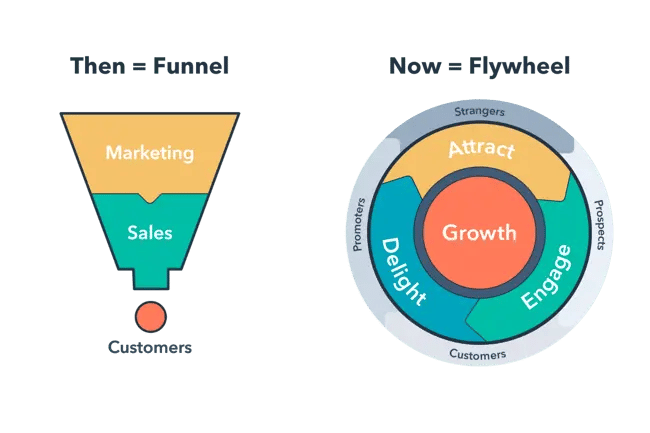
HubSpot's customer service teams, sales reps, growth specialists, and marketers — and all other teams — are trained to exceed the expectations of customers and solve for their pain points and challenges.
Additionally, HubSpot offers the HubSpot Community, HubSpot Knowledge Base, HubSpot Academy, and HubSpot Blog where customers can communicate with each other, learn from the various resources on their own time, and get immediate answers as needed.
Lastly, all HubSpot products are made to grow with customers as their businesses evolve. Engineers work to ensure the products are updated accordingly and meet the needs of all customers and buyer personas.
2. Patagonia

Patagonia does numerous things to delight their outdoors-loving customers. The brand is known for its impeccable end-to-end service, as well as its support for environmental and societal responsibility.
Patagonia delights its customers with its Ironclad Guarantee, which says anyone who isn't completely satisfied with their products can go to the company and easily choose from available options to repair, replace, or refund their purchase.
To promote its commitment to sustainability, Patagonia promises to repair any product, no matter when a customer purchased it. It helps customers do this in stores, through customer service (online and by phone), and with the Worn Wear program.
3. Sephora
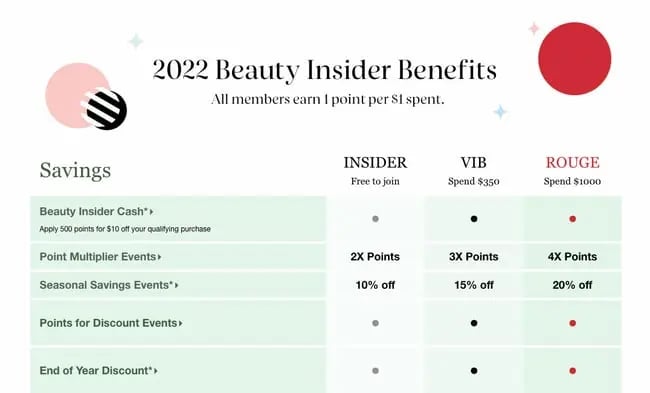
Sephora, the global cosmetics, beauty, and fragrances company, delights its customers through many marketing and service tactics.
It offers the Beauty Insider Loyalty Program to customers, which provides a wide range of benefits including in-store beauty services, free beauty classes, access to the Insider Community, and a birthday gift — just to name a few. This rewards program turns customers into advocates and keeps them coming back.
Additionally, Sephora markets its product lines with services that help customers find their perfect products. These include in-store experimentation, personalized consultations and marketing materials, and tutorials on social media.
4. Delta
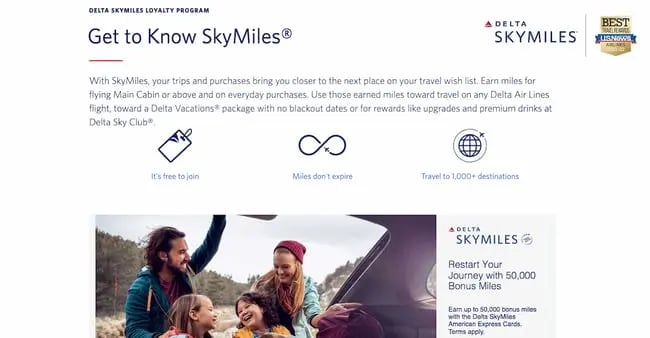
Delta is an airline that openly expresses their focus on surpassing expectations and delighting their customers on a consistent basis. Delta’s SkyMiles program is known in the industry as the best of its kind. The more you fly with Delta, the more miles you earn — and the more free flights you can redeem later down the line.
The airline also offers lounges for its Sky Club members. And if you’re only a SkyMiles member, there’s no problem; you can access the amenities for a fee. Delta consistently exceeds expectations by striving to provide a comfortable experience both on and off the plane.
During the pandemic, Delta also instituted the “Delta Care Standard,” which gives details on what the airline is doing to prevent the spread.
5. Chewy
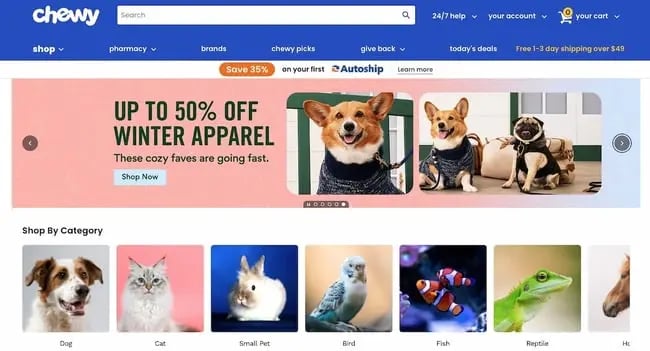
Chewy is another company that openly shares their desire to offer all of their customers with delightful experiences. They do so with their many subscription offerings, 24/7 customer support (available via multiple channels, including live chat), and by being a one-stop-shop online pet retailer.
They go above-and-beyond with their direct customer interactions, even though they’re a large-scale company. A number of customers have been forced to cancel their Chewy subscriptions due to their pets passing away, but they have reported receiving flowers and handwritten notes from Chewy employees sharing their condolences. And this Reddit user reported that Chewy sent them a portrait of their pet after their pet died.
Additionally, Chewy sends customers and their pets handwritten notes during the holidays to say, “... thanks for being a part of the Chewy family” and to express gratitude for their business. Talk about creating a delightful experience for customers.
Delight Your Customers to Grow Better
As you can see, delighting your customers is a critical aspect of your business growing better. Without implementing these strategies, your business has a much larger chance of falling behind or getting lost among dozens (or hundreds) of other competitors.
Think about how you'll delight your customers by determining which tactics you want to experiment with and looking to the examples above for inspiration. Within no time, you'll create an unforgettable customer experience that surpasses all expectations.
Editor's note: This post was originally published in November 2019 and has been updated for comprehensiveness.
-3.png?width=112&height=112&name=support%20strategy%20cover%20(3)-3.png)


![10 Customer Onboarding Challenges You Might Face This Year [+Expert Tips]](https://blog.hubspot.com/hubfs/ai%20customer%20service%20predictions%20%282%29.webp)

![Advocacy Marketing: How to Do It Well in 2023 [Strategies + Examples]](https://blog.hubspot.com/hubfs/customer-advocacy.jpg)



![What To Do if Someone Threatens to Sue You [+Customer Service Lawsuit Tips]](https://blog.hubspot.com/hubfs/196_Customer-Service-Lawsuit-Tips.png)


